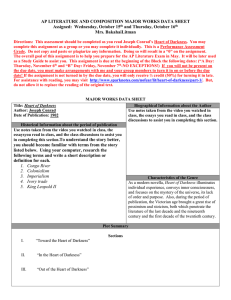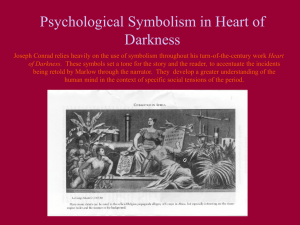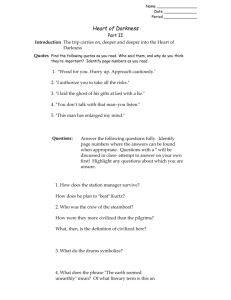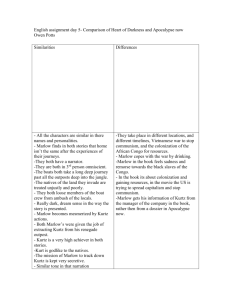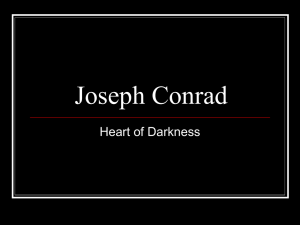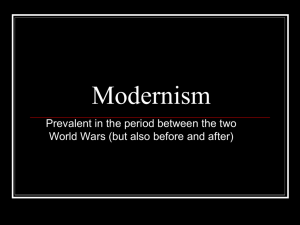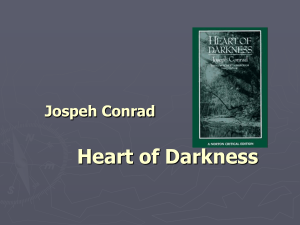Document 9928703
advertisement
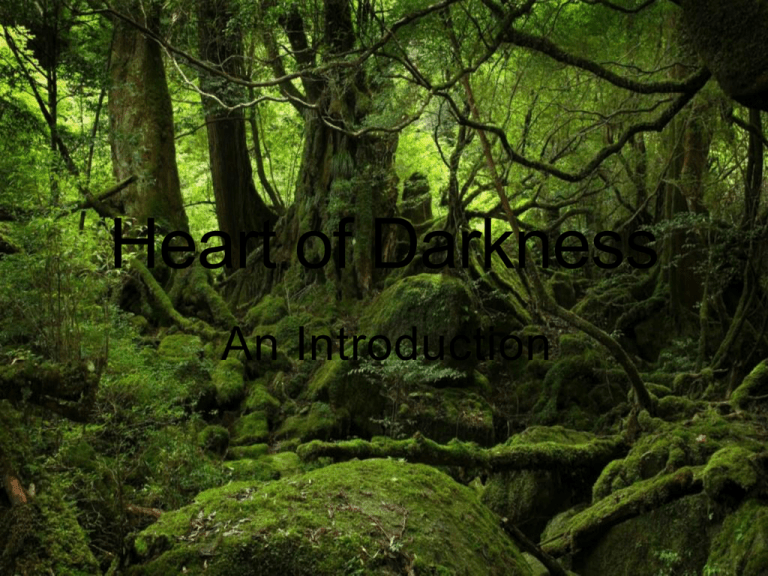
An Introduction For modern novelists, the messiness and confusion and darkness of experience is interesting. Rather than trying to simplify and abstract a particular meaning from experience, novelists tend to wallow in the multiplicity of ideas and meanings and sensations that experience can provide. Novelists are in the business of recreating and communicating the rich complexities of the experience itself. Their purpose is to get the reader to re-live an experience, with all its complexity and messiness, all its darkness and ambiguity. For Conrad, the world as we experience it is not a sort of place that can be reduced to a set of clear, explicit truths Its truths—the truths of the psyche, of the human mind and soul—are messy, vague, irrational, suggestive, and dark Conrad’s intention?: to lead his readers to an experience of the “heart of darkness.” Not to shed the light of reason on it…but to recreate his experience of darkness in our feelings, our sensibilities, our own dark and mysterious hearts Since its publication, Heart of Darkness has fascinated readers and critics, almost all of whom regard the novel as significant because of its use of ambiguity and (in Conrad's own words) "foggishness" to dramatize Marlow's perceptions of the horrors he encounters. Critics have regarded Heart of Darkness as a work that in several important ways broke many narrative conventions and brought the English novel into the twentieth century. Notable exceptions who didn't receive the novel well were the British novelist E. M. Forster, who disparaged the very ambiguities that other critics found so interesting, and the African novelist Chinua Achebe, who derided the novel and Conrad as examples of European racism. Full Title: Heart of Darkness Author: Joseph Conrad Type of Work: Novella (between a novel and a short story in length and scope) Genre: Symbolism, colonial literature, adventure tale, frame story, almost a romance in its insistence on heroism and the supernatural and its preference for the symbolic over the realistic Time and Place Written: England, 1898–1899; inspired by Conrad’s journey to the Congo in 1890 Date of First Publication: Published in 1902 in the volume Youth: A Narrative; and Two Other Stories Narrator: There are two narrators: an anonymous passenger on a pleasure ship, who listens to Marlow’s story, and Marlow himself, a middle-aged ship’s captain. Point of View: The first narrator speaks in the firstperson plural, on behalf of four other passengers who listen to Marlow’s tale. Marlow narrates his story in the first person, describing only what he witnesses and experiences, and provides his own commentary on the story. Tone: Ambivalent: Marlow is disgusted at the brutality of the Company and horrified by Kurtz’s degeneration, but he claims that any thinking man would be tempted into similar behavior. Setting (time): Latter part of the nineteenth century, probably sometime between 1876 and 1892 Setting (place): Opens on the Thames River outside London, where Marlow is telling the story that makes up Heart of Darkness. Events of the story take place in Brussels, at the Company’s offices, and in the Congo, then a Belgian territory. Protagonist: Charlie Marlow Major Conflict: Both Marlow and Kurtz confront a conflict between their images of themselves as “civilized” Europeans and the temptation to abandon morality completely once they leave the context of European society. Rising Action: The brutality Marlow witnesses in the Company’s employees, the rumors he hears that Kurtz is a remarkable man, and the numerous examples of Europeans breaking down mentally or physically in the environment of Africa. Climax: Marlow’s discovery, upon reaching the Inner Station. Falling Action: Marlow’s acceptance of responsibility for Kurtz’s legacy, Marlow’s encounters with Company officials and Kurtz’s family and friends, Marlow’s visit to Kurtz’s “Intended.” Themes: The hypocrisy of imperialism, madness as a result of imperialism, the absurdity of evil Motifs: Darkness (very seldom opposed by light), Interiors vs. surfaces (kernel/shell, Coast/inland, station/forest, etc.), Ironic understatement, Hyperbolic language, Inability to find words to describe situation adequately, Images of ridiculous waste, Upriver versus downriver / toward and away from Kurtz / away from and back toward civilization (quest or journey structure. Three: Chapters Marlow breaks off story 3 times Stations Women Central Characters Frame Narrative Light and Dark Transformation Multiplicity, ambiguity, and irony are not the easiest forms of expression to cope with when you are a student and asked to express yourself clearly and directly. But it is precisely because the world appears to us to be multiple, ambiguous, and ironic that we must strive to speak and write clearly. Otherwise—there is only darkness, only confusion. In 1890, Joseph Conrad secured employment in the Congo as the captain of a river steamboat; this was also the approximate year in which the main action of Heart of Darkness takes place. Illness forced Conrad's return home after only six months in Africa, but that was long enough for intense impressions to have been formed in the novelist's mind. Today, the river at the center of Heart of Darkness is called Zaire, and the country is the Democratic Republic of the Congo, but at the time Conrad wrote of them the country was the Belgian Congo and the river the Congo. It was not until 1877, after the English-born American explorer Henry Morton Stanley had completed a three-year journey across central Africa, that the exact length and course of the mighty Congo River were known. Stanley discovered that the Congo extends some 1,600 miles into Africa from its eastern coast to its western edge, where the river empties into the Atlantic Ocean, and that only one stretch of it is impassable. That section lies between Matadi, two hundred miles in from the mouth of the Congo, and Kinshasa, yet another two hundred miles further inland. In Heart of Darkness, Conrad calls Matadi the Company Station and Kinshasa the Central Station. Between those two places, one is forced to proceed by land, which is exactly what Marlow does on his "two hundred-mile tramp" between the two Stations, described in the book. In 1878, King Leopold II of Belgium asked Stanley to found a Belgian colony in the Congo. The King charged Stanley with setting up outposts along the Congo River, particularly at Matadi. Leopold II described his motives to the rest of Europe as springing from a desire to end slavery in the Congo and civilize the natives, but his actual desires were for material gain. In 1885, at the Congress of Berlin, an international committee agreed to the formation of a new country to be known as the Congo Free State. In Heart of Darkness, Conrad refers to this committee as the International Society for the Suppression of Savage Customs. Leopold II, who was to be sole ruler of this land, never set foot in the Congo Free State. Instead, he formed a company, called simply “the Company” in Heart of Darkness, that ran the country for him. A prevalent feeling among Europeans of the 1890s was that the African people required introduction to European culture and technology in order to become more evolved. The responsibility for that introduction, known as the "white man's burden," gave rise to a fervor to bring Christianity and commerce to Africa. What the Europeans took out of Africa in return were huge quantities of ivory. During the 1890s, at the time Heart of Darkness takes place, ivory was in enormous demand in Europe, where it was used to make jewelry, piano keys, and billiard balls, among other items. From 1888 to 1892, the amount of ivory exported from the Congo Free State rose from just under 13,000 pounds to over a quarter of a million pounds. Conrad tells us that Kurtz was the best agent of his time, collecting as much ivory as all the other agents combined. In 1892, Leopold II declared all natural resources in the Congo Free State to be his property. This meant the Belgians could stop dealing with African traders and simply take what they wanted themselves. As a consequence, Belgian traders pushed deeper into Africa in search of new sources of ivory, setting up stations all along the Congo River. One of the furthermost stations, located at Stanley Falls, was the likely inspiration for Kurtz's Inner Station. The Belgian traders committed many welldocumented acts of atrocity against the African natives, including the severing of hands and heads. Reports of these atrocities reached the European public, leading to an international movement protesting the Belgian presence in Africa. These acts, reflected in Heart of Darkness, continued, despite an order by Leopold II that they cease. In 1908, after the Belgian parliament finally sent its own review board into the Congo to investigate, the king was forced to give up his personal stake in the area and control of the Congo reverted to the Belgian government. The country was granted its independence from Belgium in 1960, and changed its name from the Democratic Republic of Congo to Zaire in 1971. What does it mean to be savage? Civilized? What are the different meanings of the words “dark” and “light”? Why do people choose to do good? Evil? Read Chapters 1-2 of Heart of Darkness

